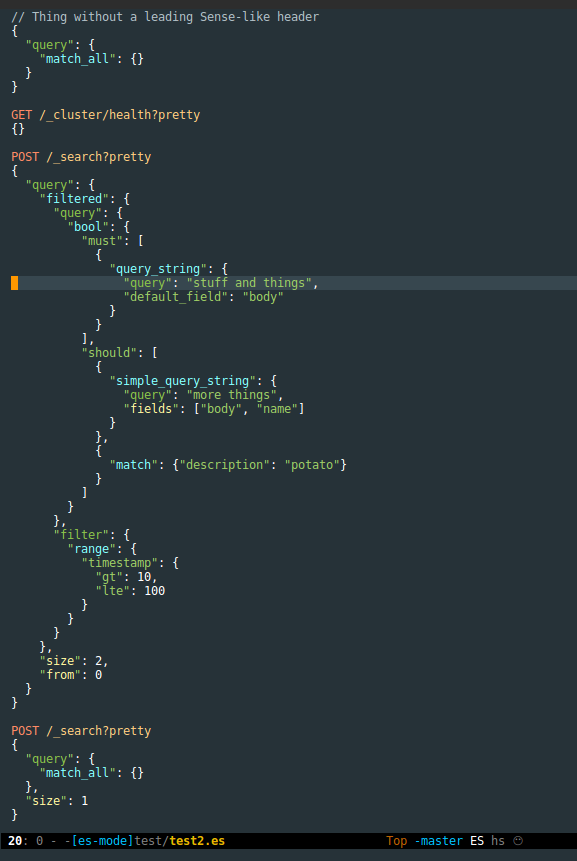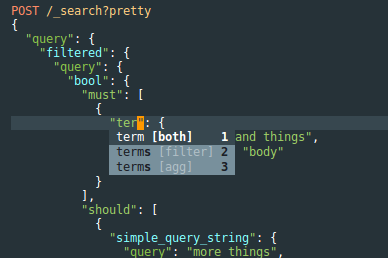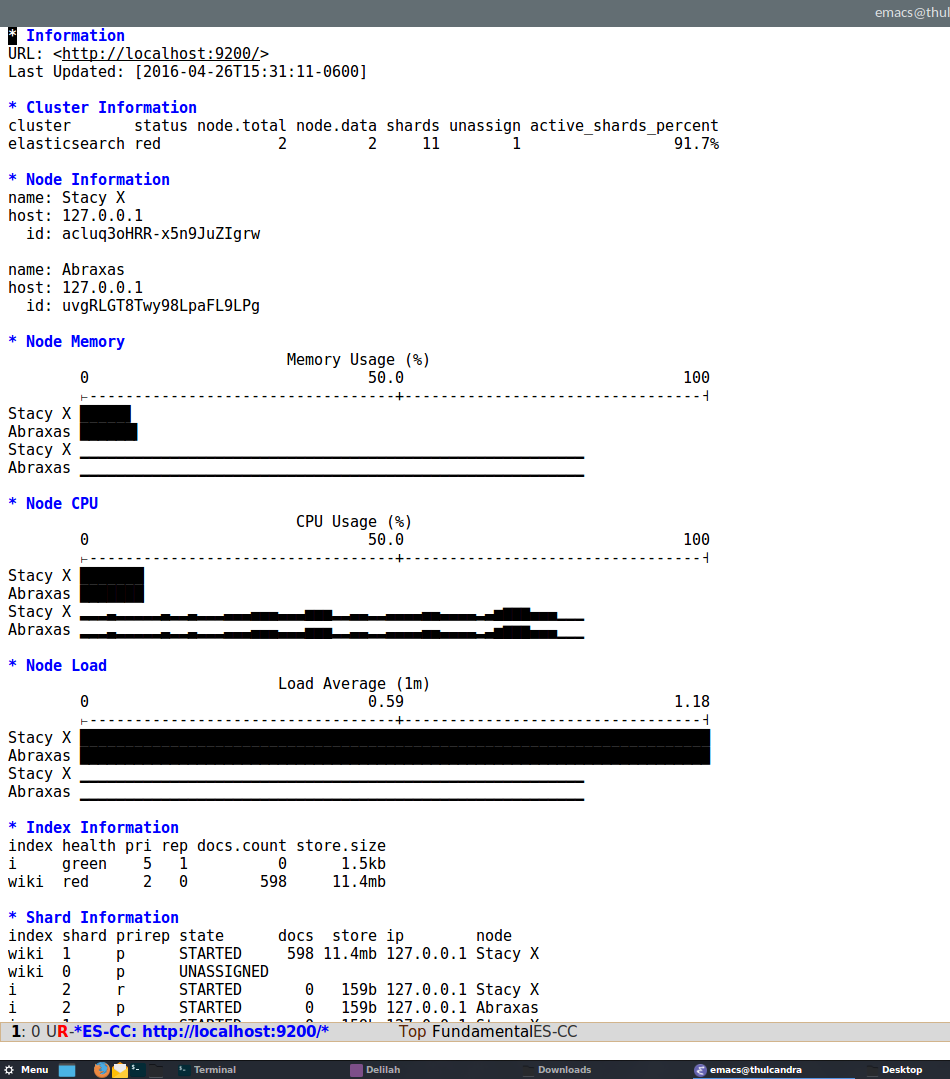dakrone / Es Mode
Labels
Projects that are alternatives of or similar to Es Mode
Elasticsearch mode for Emacs
Provides a major mode for editing ES query examples. Better highlighting and indention than sh-mode or js-mode.
It is intended to be a mixture of the three modes as well as mimicing some of the highlighting from Kibana's Dev Tools Console.
You can also think of it as Kibana's Console-envy for Emacs users.
Installation
es-mode is available in the MELPA repository. Do this, if MELPA isn't already in
your sources:
(require 'package)
(add-to-list 'package-archives
'("MELPA" . "https://melpa.org/packages/" ))
Then run M-x package-refresh-contents to load the contents of the new
repository, and M-x package-install RET es-mode RET to install es-mode.
Usage
(add-to-list 'load-path "/path/to/es-mode-dir")
(autoload 'es-mode "es-mode.el"
"Major mode for editing Elasticsearch queries" t)
(add-to-list 'auto-mode-alist '("\\.es$" . es-mode))
You can now open a file with an .es extension and es-mode will
automatically load..
Keyboard Shortcuts
| Key | Action | Description |
|---|---|---|
C-c C-c |
es-execute-request-dwim | Execute the request you're currently on |
C-c C-p |
es-goto-previous-request | Go to the previous request |
C-c C-n |
es-goto-next-request | Go to the next request |
C-c M-w |
es-copy-as | Copy the request as a curl request |
C-c C-u |
es-set-endpoint-url | Set the ES endpoint requests will be executed against |
C-c RET |
es-set-request-method | Set the rest method type (only for non-prefixed requests) |
C-c s |
(requires yasnippet) |
Insert a snippet for searching |
C-c i |
(requires yasnippet) |
Insert a snippet for new index creation |
Features
- Highlighting for builtin queries, facets, aggregations, special paramaters
- A company-mode backend for completing ES queries
- Better indenting than sh-mode (indents like js-mode)
- Sending the queries as a http-request to Elasticsearch endpoints.
- Navigate via goto-(next|previous)-request with
C-c C-nandC-c C-p(when using parameters) - An Elasticsearch Command Center mode for monitoring clusters
- Hooks for responses, see
es-response-success-functionsandes-response-failure-functions - Support for "es" mode blocks in org-mode
- Pass the resulting JSON through jq to return only the values you want in org-mode
- Displays warning headers from Elasticsearch in the results buffers for deprecated features
- Yasnippet support with built-in snippets for common operations
- Ability to copy a request as a curl request, or other
type of request (customizing
es-copy-as-fn) - Support for kibana-like triple quoting (
""") for request bodies
Using hide-show mode in results buffers
If you would like to enabled hs-minor-mode automatically on ES results
buffers, use the following:
(add-hook 'es-result-mode-hook 'hs-minor-mode)
Example
You can specify requests with two different formats:
With parameters
In the document, specify parameters similar to Console, like so:
POST /myindex/_search?pretty
{
"query": {
"match_all": {}
}
}
Hitting C-c C-c anywhere on the parameter or body of the request will execute
the request, opening a response buffer. The base-url can be configured by
customizing the es-default-url var.
You also don't have to provide the leading "/", similar to Console (I personally think the leading "/" looks better though), like this:
POST myindex/_search?pretty
{
"query": {
"match_all": {}
}
}
If you do not want to specify ?pretty every time, you can customize the
es-always-pretty-print var (defaults to nil).
Without parameters (deprecated)
Without any parameters, you can specify a request:
{
"query": {
"match_all": {}
}
}
With the request region highlighted or inside the query structure, hit C-c C-c
to execute it. The first time you do this you will be prompted for the URL and
HTTP method. You can also set the URL with C-c C-u and the method with C-c C-m.
This is deprecated in favor of the console-like syntax, as it increases complexity for maintaining es-mode.
Self signed certificates
If your ES endpoint has TLS enabled with self signed certificates (this is insecure!) you'll need to make curl ignore those. There are two ways:
- Specify
--insecurein the Emacs variablerequest-curl-options. - Create a
~/.curlrccontaining--insecure(see the curl man page).
Screenshot
See test.es, test2.es, and all.org, here's a screenshot from my theme:
And here's an example of the completion of queries/filters:
Org-babel support
One of the main reasons I started this was better highlighting and indention for org-babel. So add the snippet below to your .emacs:
(org-babel-do-load-languages
'org-babel-load-languages
'((elasticsearch . t)))
And then you will be able to hit C-c C-c on code like this in your org-mode
file:
#+BEGIN_SRC es
POST /_search?pretty
{
"query": {
"match_all": {}
}
}
#+END_SRC
OR (without parameters):
#+BEGIN_SRC es :method POST :url localhost:9200/_search?pretty
{
"query": {
"match_all": {}
}
}
#+END_SRC
org-mode uses the arguments :url and :method to know where and how
to send a query. If they are not present org-mode will use
es-default-url and es-default-request-method instead.
Tangling these blocks will produce <filename>.es, if you specify the filename
with :tangle foo.sh, es-mode will instead create a curl request for the body
of the request.
Generating org-mode tables from aggregations
Es-mode supports rudimentary table creation from aggregations using the
:tablify header parameter. For example, consider the following aggregations:
#+BEGIN_SRC es :tablify prices :results raw table
POST /test/doc/_search
{
"aggs" : {
"prices" : {
"histogram" : {
"field" : "price",
"interval" : 20,
"min_doc_count": 0
}
}
},
"size": 0
}
#+END_SRC
#+RESULTS:
| key | document count |
|-----+----------------|
| 0 | 4 |
| 20 | 0 |
| 40 | 1 |
| 60 | 2 |
| 80 | 2 |
| 100 | 1 |
| 120 | 0 |
| 140 | 0 |
| 160 | 2 |
Note that the "tablify" argument must be the name of the aggregation to be tablified, in this example, "prices" is the name of the argument.
This also works for terms aggregations:
#+BEGIN_SRC es :tablify my_terms_agg :results raw table
POST /test/doc/_search
{
"aggs" : {
"my_terms_agg" : {
"terms" : {
"field" : "type"
}
}
},
"size": 0
}
#+END_SRC
#+RESULTS:
| key | document count |
|----------+----------------|
| eggplant | 5 |
| foo | 4 |
| widget | 2 |
| cog | 1 |
If you are using org-mode 8.3.1 or later, you can generate pretty ASCII graphs
from org-mode using
orgtbl-ascii-plot
like so (hit C-c C-c on the TBLFM line to generate the graph):
#+RESULTS:
| key | document count | |
|-----+----------------+------------|
| 0 | 4 | WWWWWWWWWl |
| 20 | 0 | |
| 40 | 1 | WWc |
| 60 | 2 | WWWWV |
| 80 | 2 | WWWWV |
| 100 | 1 | WWc |
| 120 | 0 | |
| 140 | 0 | |
| 160 | 2 | WWWWV |
#+TBLFM: $3='(orgtbl-ascii-draw $2 0 5)
Or:
#+RESULTS:
| key | document count | |
|----------+----------------+--------------|
| eggplant | 5 | WWWWWWWWWWWW |
| foo | 4 | WWWWWWWWWl |
| widget | 2 | WWWWV |
| cog | 1 | WWc |
#+TBLFM: $3='(orgtbl-ascii-draw $2 0 5)
Be sure to pass the correct minimum and maximum values for the table (in this
example, 0 and 5) to the orgtbl-ascii-draw method.
Passing JSON through jq
In org-mode you can also reduce the size of results by passing them through the jq command-line tool. For example, compare the output of these two different org blocks:
#+BEGIN_SRC es
GET /
{}
#+END_SRC
#+RESULTS:
#+begin_example
{
"status" : 200,
"name" : "Everyman",
"version" : {
"number" : "1.3.2",
"build_hash" : "dee175dbe2f254f3f26992f5d7591939aaefd12f",
"build_timestamp" : "2014-08-13T14:29:30Z",
"build_snapshot" : false,
"lucene_version" : "4.9"
},
"tagline" : "You Know, for Search"
}
#+end_example
And the same thing, but passed through the jq tool, extracting the "name" and
"version.number" fields:
#+BEGIN_SRC es :jq .name, .version.number
GET /
{}
#+END_SRC
#+RESULTS:
: "Everyman"
: "1.3.2"
You can use this to return only a certain hit, or the score of a hit, etc, easily, so you can format the output as desired. See the full jq manual for how to use jq.
es-mode uses jq in the PATH, however, if you want to specify an absolute
path you can customize the es-jq-path var as you like.
jq will only be run if the response is an HTTP 20[0-9].
Variable Substitution
es-mode includes support for variable substitution in org-babel
source blocks. The variable references in the body should be in the
form ${var-name}.
#+BEGIN_SRC es :var index="theindex"
POST /${index}/_search?pretty
{
"query": {
"match_all": {}
}
}
#+END_SRC
Vars can also be used to use the results from other org-babel blocks.
In the example below, the first source block searches the index
child-docs for documents from the past month and jq is used to
select the parent-ids from the hits that are returned.
The second source block takes the parent-ids and binds it to the
variable ids in the header of the source block (:var ids=parent-ids). When the code is run ${ids} is replaced with the
JSON array prior to executing the search request against the
parent-docs index.
#+NAME: parent-ids
#+BEGIN_SRC es :jq "[.hits.hits[]._source.\"parent-id\"]"
GET /child-docs/_search?pretty
{
"query": {
{"range": {"time": {"gte": "now-1M/d"}}}
},
"_source": "parent-id"
}
#+END_SRC
#+RESULTS: parent-ids
#+begin_example
[
"id1",
"id2",
"id3"
]
#+end_example
#+BEGIN_SRC es :var ids=parent-ids
GET /parent-docs/_search?pretty
{
"query": {
{"ids": {"values": ${ids}}}
}
}
#+END_SRC
#+RESULTS:
#+begin_example
{
"took" : 227,
"timed_out" : false,
"_shards" : {
"total" : 4,
"successful" : 4,
"failed" : 0
},
"hits" : {
"total" : 3,
"max_score" : 5.3673162,
"hits" : [
{
"_index" : "parent-docs",
"_type" : "t",
"_id" : "id1",
"_score" : 5.3673162,
"_source" : {
...
}
},
{
"_index" : "parent-docs",
"_type" : "t",
"_id" : "id2",
"_score" : 5.3673162,
"_source" : {
...
}
},
{
"_index" : "parent-docs",
"_type" : "t",
"_id" : "id3",
"_score" : 5.3673162,
"_source" : {
...
}
}
]
}
}
#+end_example
Elasticsearch Command Center
es-mode includes a mode called the "Elasticsearch Command Center", which is
meant for monitoring your cluster. This provides a graphical representation of
what's happening in the cluster.
To invoke it, simply do M-x es-command-center. ES-CC will automatically
refresh at es-cc-refresh-interval seconds, check out M-x customize-group es-cc to see all of the customization options.
Here's a screenshot of what it looks like:
Feedback
This is my first major mode for Emacs, feedback is welcome, especially pull requests that show me what I'm doing wrong.



